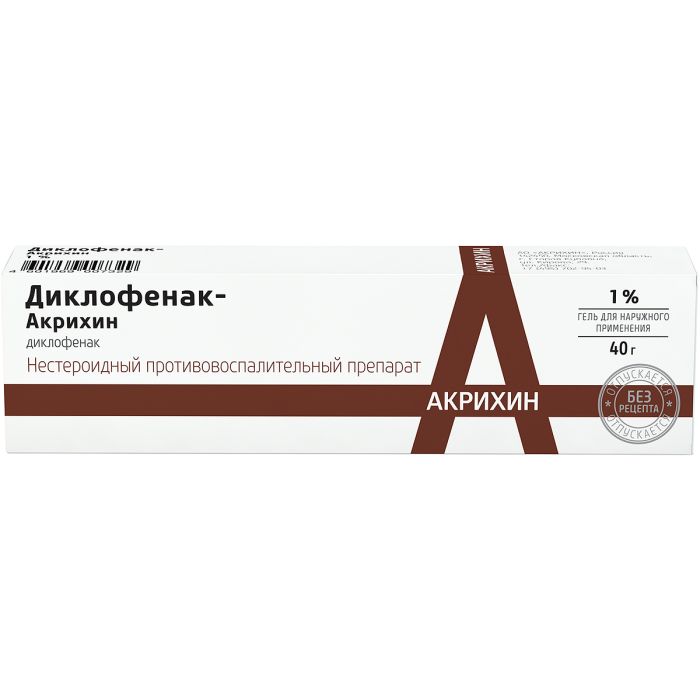Diclofenac-Akrikhin 1% 40.0 Gel for external use, Tube
Category
Bruises, sprains
Scope of the drug
Musculoskeletal system
Release form
Gel
Manufacturer country
Russia
Package quantity, pcs
one
Dosage form
Gel for external use 1% from white to white with a yellowish or grayish tint, with a specific odor.
Structure
100 g
diclofenac sodium 1 g
Excipients: ethanol (rectified ethyl alcohol) - 25 g, propylene glycol - 5 g, carbomer 940 (carbopol 980) - 0.9 g, diethanolamine - 1 g, liquid paraffin (vaseline oil) - 2.5 g, cocoil caprilocaprate - 2.5 g, macrogol cetostearate (macrogol 20 cetostearyl ether) - 2 g, lavender oil - 0.05 g, orange blossom oil (neroli oil) - 0.05 g, purified water - up to 100 g.
general description
Non-steroidal anti-inflammatory drug
Special conditions
The gel should only be applied to intact skin, avoiding contact with open wounds.
After application, do not apply an occlusive dressing.
Avoid contact with the eyes and mucous membranes.
When using the drug in conjunction with other dosage forms of diclofenac, the maximum daily dose should be taken into account.
When applied to large skin surfaces for a long time, the risk of developing systemic side effects characteristic of NSAIDs increases.
Overdose
Extremely low systemic absorption of the active components of the drug when applied externally makes an overdose almost impossible.
Drug interactions
The drug can enhance the effect of drugs that cause photosensitization.
No clinically significant interaction with other drugs has been described.
Pharmacodynamics
The active ingredient diclofenac is a non-steroidal anti-inflammatory drug (NSAID) with pronounced analgesic and anti-inflammatory properties.
By indiscriminately inhibiting type 1 and type 2 cyclooxygenase, it disrupts the metabolism of arachidonic acid and the synthesis of prostaglandins, which are the main link in the development of inflammation.
Diclofenac-Acri is used to relieve pain and reduce swelling associated with the inflammatory process.
When applied topically, it causes relief or disappearance of joint pain at rest and during movement.
Reduces morning stiffness and swelling of joints, increases range of motion.
Pharmokinetics
When applied topically, systemic absorption is no more than 6%.
When applied to the area of the affected joint, the concentration in the synovial fluid is higher than in the plasma.
Indications
- post-traumatic inflammation of soft tissues and joints, for example, as a result of sprains, strains and bruises
- rheumatic diseases of soft tissues (tendovaginitis, bursitis, damage to periarticular tissues)
- pain and swelling associated with diseases of muscles and joints (rheumatoid arthritis, osteoarthritis, radiculitis, lumbago, sciatica, muscle pain of rheumatic and non-rheumatic origin).
Contraindications
- anamnestic data about an attack of bronchial obstruction, rhinitis, urticaria after taking acetylsalicylic acid or other NSAIDs
- pregnancy (III trimester)
- lactation period
- children up to age 12
- violation of the integrity of the skin
- hypersensitivity to diclofenac or other components of the drug, to acetylsalicylic acid or other NSAIDs.
Carefully
Hepatic porphyria (exacerbation), erosive and ulcerative lesions of the gastrointestinal tract, severe liver and kidney dysfunction, chronic heart failure, old age, bronchial asthma, pregnancy (I and II)
Application during pregnancy and lactation
The drug should not be used in the third trimester of pregnancy.
There is no experience of using the drug during lactation.
Use in the I and II trimesters is possible only after consulting a doctor.
Side effects
Local reactions: eczema, photosensitivity, contact dermatitis (itching, redness, swelling of the treated skin area papules, vesicles, peeling).
Systemic reactions: generalized skin rash, allergic reactions (urticaria, angioedema, bronchospastic reactions).
Dosage
1% x 40g
Indications
Post-traumatic inflammation of soft tissues and joints, for example, as a result of sprains, strains and bruises
rheumatic diseases of soft tissues (tendovaginitis, bursitis, damage to the periarticular tissues)
pain syndrome and swelling associated with diseases of muscles and joints (rheumatoid arthritis, osteoarthritis, radiculitis, lumbago, sciatica, muscle pain of rheumatic and non-rheumatic origin).
Storage conditions and periods
At a temperature of 15-25 degrees.
Expiration date: 3 years
Contraindications
Anamnestic data about an attack of bronchial obstruction, rhinitis, urticaria after taking acetylsalicylic acid or other NSAIDs
pregnancy (III trimester)
lactation period
children under 12 years of age
violation of the integrity of the skin
hypersensitivity to diclofenac or other components of the drug, to acetylsalicylic acid or other NSAIDs.
Carefully:
Hepatic porphyria (exacerbation), erosive and ulcerative lesions of the gastrointestinal tract, severe liver and kidney dysfunction, chronic heart failure, old age, bronchial asthma, pregnancy (I and II)
Application during pregnancy and lactation
the drug should not be used in the third trimester of pregnancy.
There is no experience of using the drug during lactation.
Use in the I and II trimesters is possible only after consulting a doctor.
INN / Active ingredient
Diclofenac
Specifications
Category
Bruises, sprains
Scope of the drug
Musculoskeletal system
Release form
Gel
Manufacturer country
Russia
Package quantity, pcs
one
Vacation conditions
Without recipe
Brand name
Akrikhin
The amount of the dosage form in the primary package
40 g
Primary packaging type
Tuba
Type of consumer packaging
Pack of cardboard
Pharmaco-therapeutic group
Non-steroidal anti-inflammatory drug
Anatomical and therapeutic characteristics
M02AA15 Diclofenac
Dosage form
Gel for external use
Drug action
Anti-inflammatory
,
Analgesic
Expiration date in days
1095
Package weight, g
55
Information on technical characteristics, delivery set, country of manufacture

